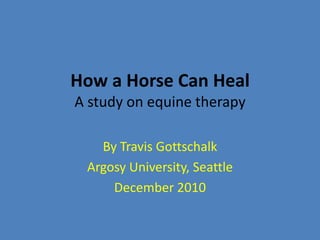
How A Horse Can Heal
- 1. How a Horse Can HealA study on equine therapy By Travis Gottschalk Argosy University, Seattle December 2010
- 2. Who do they help? What is Animal Therapy? Animals can be used in a therapeutic way to try to help people cope, build life skills, and help create strong bonds. Animal therapy clients are typically people that suffer from mental disabilities, social skills, and physical aliments.
- 3. What is Equine Therapy? Equine Therapy 101 Equine therapy is a type of animal therapy that uses horses to build relationship skills among other things.
- 4. Typical Clients Equine therapy is a form of animal therapy for people who have a range of disabilities including physical, emotional, cognitive, and social difficulties. Some of the clients suffer from some of the following issues Chemical and alcohol abuse Anxiety attacks and phobias Learning disabilities Post Traumatic Stress Disorder Autism&Asperger Syndrome Victims of abuse Depression Down's syndrome (Trask, 2010).
- 9. My Experience continued…. The Cowboy-Up Program Cowboy-Up is dedicated to assist troubled youth in our communities. In this youth program they use horses to teach… Responsibility Respect Self-awareness Positive attitudes Positive choices Manners They use the change in surroundings and expectations to instill in young people the idea that what they are accustomed to is not all that there is.
- 10. Research In the late 1990's, Institute of Developmental Psychology in Leipzig, Germany. The ten participants all had varying types and degrees of behavioral and emotional issues including eating and anxiety disorders. Each teen spent 30 minutes with a therapy animal. The participant being observed for changes in four different response indicators: gaze direction posture behavior towards the dog behavior towards the therapist All ten of the participants showed significant behavioral changes when interacting with the therapy dogs (Animal, 2010).
- 11. Physiological Reactions Studies have shown that spending time with a friendly animal, even a short time like 10 to 15 minutes, increases the amount of endorphins that are released into the body and decreases the levels of a chemical called cortisol. What is Cortisol? It is a hormone that controls stress and arousal. What does this mean for troubled teens? Because many troubled teens are in a near-constant state of emotional arousal and/or stress, animal assisted therapy can help them feel calmer (Animal, 2010).
- 12. References Animal Assisted Therapy for Troubled Teens. (2010). Equine Assisted Psychotherapy. Retrieved December 3, 2010, from http://www.equine-therapy-programs.com/troubledteens.html Haubenhofer, D., Mostl, E., & Kirchengast, S. (2005). Cortisol concentrations in saliva . Research in Human-Animal Interaction. Retrieved December 3, 2010, from http://www.anthrozoology.org/cortisol_concentrations_in_saliva_of_humans_and_their_dogs_during_intensive_training_courses_in_animal_assisted_therapy Klontz, B. T., Bivens, A., Leinart, D., & Klontz, T. (2007). The Effectiveness of Equine-Assisted Experiential Therapy: Results of an Open Clinical Trial. Journal of Society & Animals, 15, 257-267. Pichot, T., & Coulter, M. (2007). Animal-assisted brief therapy: a solution-focused approach. New York : Haworth Press. Rothe, E. Q., Vega, B. J., Soler, S. M., Torres, R. M., & Pazos, R. M. (2005). From kids and horses: Equine facilitated psychotherapy for children. International Journal of Clinical and Health Psychology, 5(2), 373-383. Trask, L. (2010, October 20). Helping With Horses: Equine Assisted Psychotherapy. Psychology Today.
Editor's Notes
- Talk about Therapy dogs used for help reading.
- Discuss how the interactions with the horses teaches these skills
- Talk about David Boyd
- Talk about some of the success stories
- Discuss how the lower levels of cortisol affect your stress levels